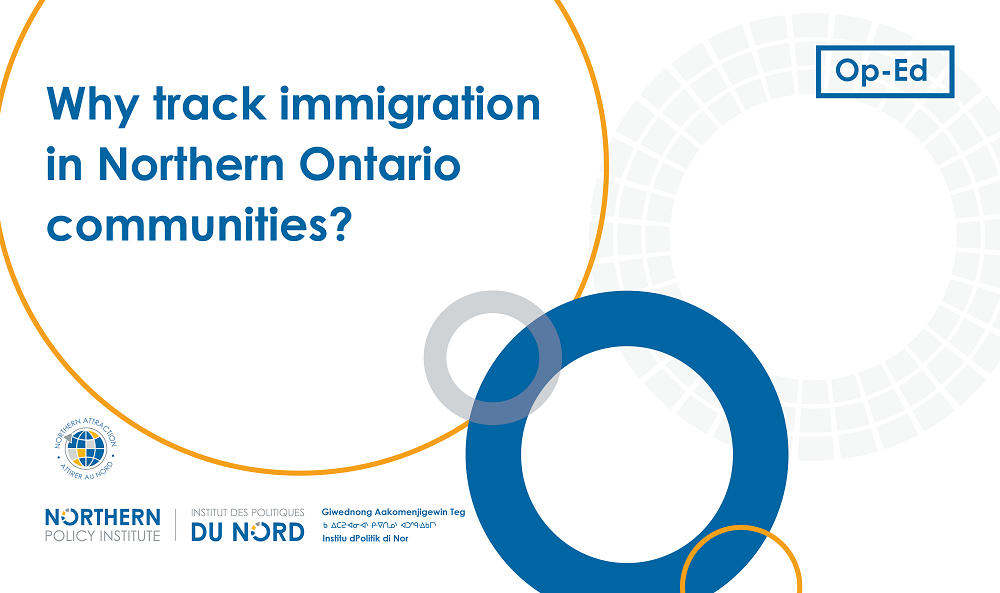Why track immigration in Northern Ontario communities?
April 2022 - All roads lead home: Immigration flows into Ontario’s north and what this means for RNIP impacts, lays out current immigration levels and characteristics in Northern Ontario’s five largest cities: North Bay, Timmins, Sault Ste. Marie, Thunder Bay, and Greater Sudbury.

How do you measure the impact of policy pilots? Well, one of the ways is by establishing a baseline. In the case of the Rural and Northern Immigration Pilot (RNIP) in Northern Ontario, that is what NPI's latest papers have set out to do.
To combat the labour market impacts, the RNIP program has been implemented across five of Northern Ontario’s largest cities. The RNIP aims to spread the benefits of economic immigration to small communities with demonstrated need, by creating a path to permanent residence for skilled foreign workers who want to work and live in one of the participating communities.
The Pilot is community-led, meaning communities (not decision-makers in Toronto or Ottawa) can identify the unique skills gaps their employers are facing. Communities can also select criteria that will identify candidates that are more likely to remain in the communities after receiving their PR, such as: having family in the community, having lived in a cold climate before, and having studied or lived in the community.
To aid communities in sustainable economic immigration, we can monitor and assess what criteria and characteristics aid in attraction and long-term retention. Are the targeted occupations broad enough to attract the allotted number of candidates, while still being specific enough to fill identified labour shortages? Do factors such as time spent in the community and education level, aid in retention? To do this analysis, there must first be a baseline established.
Specifically, as this Pilot is meant to fill local labour shortages through immigration, items to track is the alignment between immigrant-intended occupations, targeted RNIP occupations, occupations with high vacancy rates, and positive labour market impact assessments (LMIAs) issued.
While most findings vary by community, there are two findings in particular that are applicable across all five pilot communities. First, the papers find that the main immigration stream used currently by permanent residents in Northern Ontario’s five largest cities is “economic”. The most common intended occupations by these “economic” migrants do not, however, align with occupations with high vacancy rates in those cities. The RNIP program has shifted the focus to more demand-based targeting, but there is still considerable variance between jobs in highest demand and the occupations targeted by RNIP.
To fully utilize the economic capacity of newcomers to our regions, effectively measure the success of RNIP, and promote sustainable economic growth through immigration, five recommendations are to be considered:
- Ongoing annual monitoring and assessment of community-level immigration trends;
- Community-specific ongoing assessment of the impact of the Rural and Northern Immigration Pilot (RNIP) before, during, and after the program;
- Expanded analysis to include secondary and domestic migrants;
- Strengthening the alignment between labour market shortages, targeted occupations, post secondary institutional fields of study, and immigrant-intended occupations to maximize economic outcomes;
- Undertaking welcoming community initiatives to welcome, attract, and retain immigrants and the existing population.
Establishing a baseline is only one of many steps to ensure a successful pilot in Northern Ontario’s communities. As well, the impacts of RNIP are not only limited to economic success. Encouraging welcoming communities and sustainable growth benefits you, your neighbours, your co workers, and the community at large.
Mercedes Labelle is a Lead Analyst at NPI
Write for us
The content of Northern Policy Institute’s blog is for general information and use. The views expressed in this blog are those of the author and do not necessarily reflect the opinions of Northern Policy Institute, its Board of Directors or its supporters. The authors take full responsibility for the accuracy and completeness of their respective blog posts. Northern Policy Institute will not be liable for any errors or omissions in this information, nor will Northern Policy Institute be liable for any detriment caused from the display or use of this information. Any links to other websites do not imply endorsement, nor is Northern Policy Institute responsible for the content of the linked websites.
Northern Policy Institute welcomes your feedback and comments. Please keep comments to under 500 words. Any submission that uses profane, derogatory, hateful, or threatening language will not be posted. Please keep your comments on topic and relevant to the subject matter presented in the blog. If you are presenting a rebuttal or counter-argument, please provide your evidence and sources. Northern Policy Institute reserves the right to deny any comments or feedback submitted to www.northernpolicy.ca that do not adhere to these guidelines.
